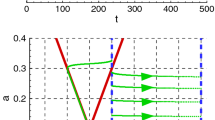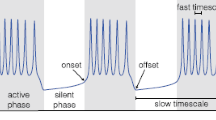Abstract
Bursting electrical activity is ubiquitous in excitable cells such as neurons and many endocrine cells. The technique of fast/slow analysis, which takes advantage of time scale differences, is typically used to analyze the dynamics of bursting in mathematical models. Two classes of bursting oscillations that have been identified with this technique, plateau and pseudo-plateau bursting, are often observed in neurons and endocrine cells, respectively. These two types of bursting have very different properties and likely serve different functions. This latter point is supported by the divergent expression of the bursting patterns into different cell types, and raises the question of whether it is even possible for a model for one type of cell to produce bursting of the type seen in the other type without large changes to the model. Using fast/slow analysis, we show here that this is possible, and we provide a procedure for achieving this transition. This suggests that the design principles for bursting in endocrine cells are just quantitative variations of those for bursting in neurons.
Similar content being viewed by others
References
Al-Baldawi, N. F., & Abercrombie, R. F. (1995). Cytoplasmic calcium buffer capacity determined with Nitr-5 and DM-nitrophen. Cell Calcium, 17, 409–421.
Berlin, J. R., Bassani, J. W. M., & Bers, D. M. (1994). Intrinsic cytosolic calcium buffering properties of single rat cardiac myocytes. Biophys. J., 67, 1775–1787.
Bertram, R., & Sherman, A. (2004). A calcium-based phantom bursting model for pancreatic islets. Bull. Math. Biol., 66, 1313–1344.
Bertram, R., & Sherman, A. (2005). Negative calcium feedback: the road from Chay–Keizer. In S. Coombes, & P. Bressloff (Eds.), The genesis of rhythm in the nervous system (pp. 19–48). New Jersey: World Scientific Press.
Bertram, R., Butte, M. J., Kiemel, T., & Sherman, A. (1995). Topological and phenomenological classification of bursting oscillations. Bull. Math. Biol., 57, 413–439.
Chay, T., & Keizer, J. (1983). Minimal model for membrane oscillations in the pancreatic β-cell. Biophys. J., 42, 181–190.
Ermentrout, B. (2002). Simulating, analyzing, and animating dynamical systems: a guide to XPPAUT for researchers and students. Philadelphia: SIAM.
Izhikevich, E. M. (2000). Neural excitability, spiking and bursting. Int. J. Bifur. Chaos, 10, 1171–1266.
LeBeau, A. P., Robson, A. B., McKinnon, A. E., & Sneyd, J. (1998). Analysis of a reduced model of corticotroph action potentials. J. Theor. Biol., 192, 319–339.
Mansvelder, H. D., & Kits, K. S. (1998). The relation of exocytosis and rapid endocytosis to calcium entry evoked by short repetitive depolarizing pulses in rat melanotropic cells. J. Neurosci., 18, 81–92.
Mennerick, S., & Matthews, G. (1996). Ultrafast exocytosis elicited by calcium current in synaptic terminals of retinal bipolar neurons. Neuron, 17, 1241–1249.
Prinz, A. A., Abbott, L. F., & Marde, E. (2004). The dynamic clamp comes of age. Trends Neurosci., 27, 218–224.
Rinzel, J. (1987). A formal classification of bursting mechanisms in excitable systems. In E. Teramoto, & M. Yamaguti (Eds.), Lecture notes in biomathematics : Vol. 71. Mathematical topics in population biology, morphogenesis, and neurosciences (pp. 267–281). Berlin: Springer.
Roussel, C., Erneux, T., Schiffmann, S., & Gall, D. (2006). Modulation of neuronal excitability by intracellular calcium buffering: from spiking to bursting. Cell Calcium, 39, 455–466.
Sharp, A. A., O’Neil, M. B., Abbott, L. F., & Marder, E. (1993). Dynamic clamp: computer-generated conductances in real neurons. J. Neurophysiol., 69, 992–995.
Sheng, Z. H., Rettig, J., Cook, T., & Catterall, W. A. (1996). Calcium-dependent interaction of N-type calcium channels with the synaptic core complex. Nature, 379, 451–454.
Stern, J. V., Osinga, H. M., LeBeau, A., & Sherman, A. (2008). Resetting behavior in a model of bursting in secretory pituitary cells: distinguishing plateaus from pseudo-plateaus. Bull. Math. Biol., 70, 68–88.
Stojilkovic, S. S., Zemkova, H., & Van Goor, F. (2005). Biophysical basis of pituitary cell type-specific Ca2+ signaling-secretion coupling. Trends Endocrinol. Metabol., 16, 152–159.
Tabak, J., Toporikova, N., Freeman, M. E., & Bertram, R. (2007). Low dose of dopamine may stimulate prolactin secretion by increasing fast potassium currents. J. Comput. Neurosci., 22, 211–222.
Tsaneva-Atanasova, K., Sherman, A., Van Goor, F., & Stojilkovic, S. S. (2007). Mechanism of spontaneous and receptor-controlled electrical activity in pituitary somatotrophs: experiments and theory. J. Neurophysiol., 98, 131–144.
Tse, F. W., Tse, A., Hille, B., Horstmann, H., & Almers, W. (1997). Local Ca2+ release from internal stores controls exocytosis in pituitary gonadotrophs. Neuron, 18, 121–132.
Van Goor, F., Li, Y.-X., & Stojilkovic, S. S. (2001a). Paradoxical role of large-conductance calcium-activated K+ (BK) channels in controlling action potential-driven Ca2+ entry in anterior pituitary cells. J. Neurosci., 21, 5902–5915.
Van Goor, F., Zivadinovic, D., Martinez-Fuentes, A. J., & Stojilkovic, S. S. (2001b). Dependence of pituitary hormone secretion on the pattern of spontaneous voltage-gated calcium influx. Cell type-specific action potential secretion coupling. J. Biol. Chem., 276, 33840–33846.
Zhang, M., Goforth, P., Bertram, R., Sherman, A., & Satin, L. (2003). The Ca2+ dynamics of isolated mouse β-cells and islets: implications for mathematical models. Biophys. J., 84, 2852–2870.
Author information
Authors and Affiliations
Corresponding author
Rights and permissions
About this article
Cite this article
Teka, W., Tsaneva-Atanasova, K., Bertram, R. et al. From Plateau to Pseudo-Plateau Bursting: Making the Transition. Bull Math Biol 73, 1292–1311 (2011). https://doi.org/10.1007/s11538-010-9559-7
Received:
Accepted:
Published:
Issue Date:
DOI: https://doi.org/10.1007/s11538-010-9559-7




